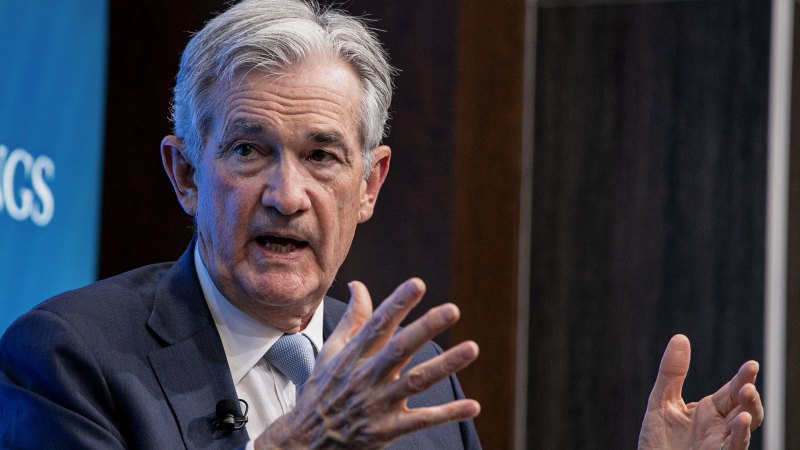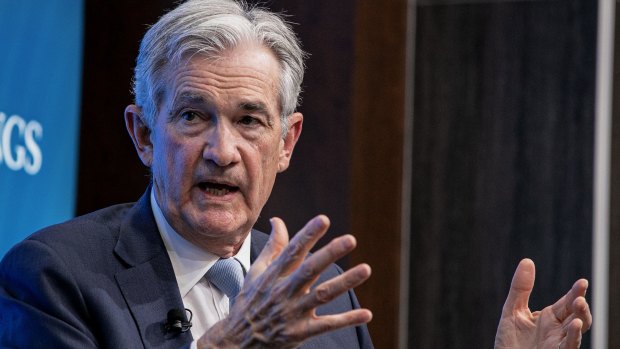Financial markets and the Fed are set on a collision course
The US Federal Reserve Board and financial markets appear to have quite divergent views on the outlook for inflation and the US economy. That’s not necessarily going to produce a good outcome for investors, or the US and global economies.
The Fed, as was expected, announced a 50 basis point increase in the federal funds rate (equivalent to the Reserve Bank’s cash rate) on Wednesday local time and is now targeting a range of 4.25 per cent to 4.5 per cent for its policy rate.
At the start of the year, the range targeted was 0 to 0.25 per cent but, as the US inflation rate surged – it hit 9.1 per cent in June – the Fed has ratcheted up interest rates at a pace last seen in the 1980s.
Fed chief Jerome Powell says it was too soon to talk about cutting interest rates.Credit:Bloomberg
While the latest increase was smaller than the previous four 75-basis-point increments, the Fed’s Open Market Committee (FOMC), which determines US monetary policy, said it anticipated that more rate hikes would be appropriate to achieve a monetary policy restrictive enough to return the inflation rate to 2 per cent over time.
The “dot plot” chart of the FOMC members’ projections showed that their expectations for both inflation and the federal funds rate next year have risen from their last projections in September, with core inflation (which excludes fuel and food prices) rising from 2.8 per cent in September to 3.1 per cent and the median projection for the federal funds rate rising from 4.6 per cent to 5.1 per cent. Four members see the rate reaching 5.5 per cent next year.
The projections are for the final quarter of 2023, so most members see US interest rates remaining above 5 per cent until 2024, when the median projection is for it to fall back to 4.1 per cent by the end of that year.
That’s even though economic data this week essentially confirmed that US inflation has peaked and is declining at a faster rate than markets had anticipated. The headline rate fell from 7.7 per cent in October to 7.1 per cent last month, and the core rate for the last three months is down to 4.3 per cent.
That had led to falling yields in the US bond market on Tuesday and enthusiasm in the sharemarket. Investors were already pricing in an earlier and lower peak to US rates than the Fed and the inflation data supported that view.
Despite the FOMC projections and a continuing hawkish tone from Fed chairman Jerome Powell, who said after the release off the rate decision that “inflation risks are to the upside” and pointed out that 17 of the 19 FOMC members expect rates to climb to or above 5 per cent next year, Treasury bond yields slid again on Wednesday.
‘More work to do’
Powell rejected the notion of the rate cut next year, which has been priced into the bond market, and said the Fed had “more work to do” and “a long ways to go” to achieve price stability.
The market seemed to ignore those comments and the weight of the FOMC projections, with the yields on two-year notes falling 16 basis points to 4.2 per cent and those on 10-year bonds 36 basis points to 3.48 per cent.
Those yields have fallen sharply over the past month as investors have become convinced the federal funds rate would top out by the middle of next year and fall in the second half. Only a month ago, the two-year yield was 4.73 per cent and the 10-year yield 4.22 per cent.
The US sharemarket, which initially slid in response to the FOMC commentary, regained most of that ground to end down only 0.7 per cent.
Financial markets, including the currency market where the US dollar has weakened markedly, could be said to have been undermining, or at least blunting, the Fed’s efforts to tighten its monetary settings.
In the absence of a reversal of the recent trend in inflation data, that creates friction between the Fed’s expectations and those of the market, where the real-world impact of changes to interest rates is actually felt, and could force the Fed to be more aggressive than it might otherwise be to force investors into line with its own convictions.
It could mean higher official rates and those higher rates being sustained for longer, and/or the Fed could change its current quantitative tightening policy, where it is allowing its balance sheet to shrink by not reinvesting the proceeds from the maturation of bonds it bought during the worst of the pandemic. It could sell those bonds, adding to the supply of bonds and generating more upward pressure on yields across the yield curve.
The FOMC’s increases in projections for inflation and rates next year were made despite revisions downwards on its members’ median projection for economic growth next year, from the September projection of 1.2 per cent to 0.5 per cent.
The Fed is data-driven, which means it reacts to the data rather than adopting a more forward-looking approach, which could lead to over-kill and a greater economic downturn and an avoidable recession, or a recession that is deeper than it might otherwise have been.
Central banks’ dilemma
The US central bank – and Powell – seem scarred by the experience of the early 1980s, after out-of-control inflation (it was almost 15 per cent in early 1980) was eventually crushed when its then-chairman, Paul Volcker, raised the federal funds rate to 20 per cent and forced the economy into the 1980-82 recession which, until the financial crisis in 2008, was regarded as the worst recession in the US since the Great Depression.
It would seem the Fed policymakers are prepared to risk doing too much and create avoidable damage in the process, rather than doing too little and repeating the 1970s experience of failing to contain inflation.
Around the world, the experience of other economies is proving similar to that of the US, and their central banks face similar dilemmas.
While some inflation rates have been higher than that of the US – the UK and Germany have been above 10 per cent and some, like Australia, lower – all the recent data says that they have peaked.
The global supply chain disruption that was a key factor in igniting inflation has steadily receded, the pandemic spending binge by consumers aided by massive fiscal stimulus has ended, and sky-high oil prices have now fallen back.
Few would argue against what the Fed and other central banks have done thus far in response to the 40-year high inflation rates.
But the monetary policy task will get harder next year if those inflation rates keep falling and central banks have to make more subjective assessments of how high their interest rates should go, and how long they should sustain their peak before they start cutting them again.
There’s a lot of economic growth, people’s lives and livelihoods and the outlook for financial markets riding on the judgement calls those central bankers will be confronted with next year.
The Business Briefing newsletter delivers major stories, exclusive coverage and expert opinion. Sign up to get it every weekday morning.
Most Viewed in Business
From our partners
Source: Read Full Article


